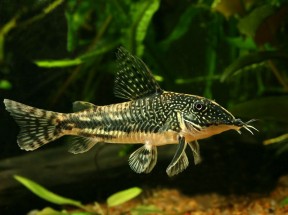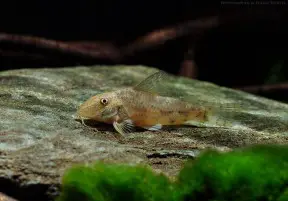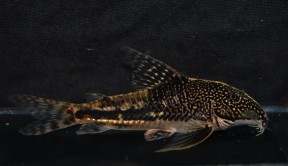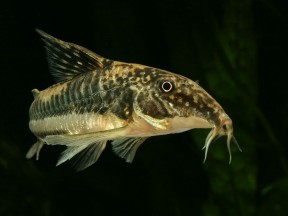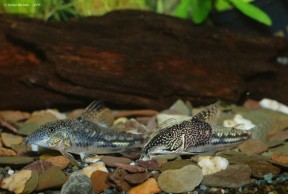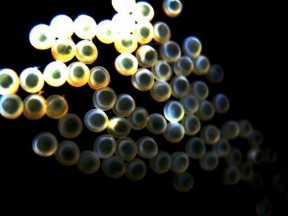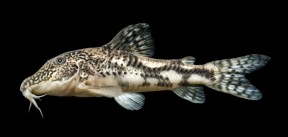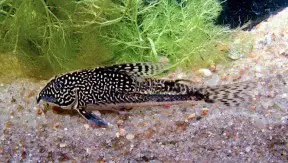Scleromystax barbatus
Banded 'Cory'
SynonymsTop ↑
Callichthys barbatus Quoy & Gaimard, 1824; Corydoras barbatus (Quoy & Gaimard, 1824); Corydoras eigenmanni Ihering, 1907; Corydoras kronei Miranda Ribeiro, 1907
Etymology
Scleromystax: from the Ancient Greek σκληρός (sklērós), meaning ‘hard’, and μύσταξ (mústaks), meaning ‘upper lip’.
barbatus: from the Latin barbatus, meaning ‘bearded’.
Classification
Order: Siluriformes Family: Callichthyidae
Distribution
Occurs in tributaries of the coastal rios Guapi, Capivari, and Inbomirim in south-eastern Brazil, between Rio de Janeiro and Santa Catarina.
Type locality is ‘Fazenda da Japuhyba near Angra dos Reis, 22°59’S, 44°17’W, Rio de Janeiro, Brazil’.
Habitat
Although found in coastal basins, the fish only occurs in freshwater; this and all species in the genus inhabit small flowing tributary streams and still ponds having a substrate of sand or fine pebbles often covered by mud (Britto & Reis, 2005).
Maximum Standard Length
90 – 100 mm; the largest of the known Corydoradinae.
Aquarium SizeTop ↑
Minimum base dimensions of 120 ∗ 45 cm or equivalent are recommended.
Maintenance
Ideally use a substrate of fine sand, although rounded gravel is an acceptable alternative provided it’s kept scrupulously clean.
Other décor is largely down to personal choice, but some cover should be provided, particularly if you wish to keep more than a single male.
Water Conditions
Temperature: 16 – 24 °C
pH: 5.5 – 7.5
Hardness: 18 – 215 ppm
Diet
Scleromystax spp. are foraging omnivores, and most will accept sinking dried foods as well as small live and frozen varieties such as chironomid larvae (bloodworm), Tubifex, etc. Feeding a varied diet will ensure the fish are in optimum condition.
Under no circumstances should they be expected to survive on ‘left-overs’ from other inhabitants of the aquarium or relied on to ‘clean’ the aquarium.
Behaviour and CompatibilityTop ↑
Males are aggressively territorial towards one another and cannot be maintained together in smaller aquaria, otherwise peaceful..
Sexual Dimorphism
Male has a white/gold stripe against black on the forehead, more defined spotted pattern on the head and facial bristles like a beard. Females have a more rounded body, particularly when in breeding condition, and are slightly larger.
Reproduction
Can be bred in a similar fashion to many Corydoras species.
Use a ratio of a single males per female in order to avoid rival males concentrating on each other, and when the female is visibly full of eggs perform a large (50-70%) water change with cooler water, and increase oxygenation and flow in the tank. Repeat this daily until the fish spawn.
Eggs may be deposited on the aquarium glass, among fine-leaved vegetation or within sunken spawning mops, with the latter particularly recommended since they facilitate easy removal of eggs.
Once spawning is complete either adults or eggs should be removed; the latter can usually be rolled gently up the glass with a finger. The new container should contain the same water as the spawning tank and be similarly well-oxygenated.
Most breeders add a few drops of methylene blue, or an alder cone or two at this point in order to prevent the eggs developing fungus.
Incubation is normally 3-4 days and once the fry have fully-absorbed their yolk sacs they are able to accept small live foods such as microworm, Artemia nauplii, etc.
They are not the easiest to raise, requiring excellent water quality, but seem less susceptible to ailments when maintained over a thin layer of sand rather than in a bare arrangement.
NotesTop ↑
This species is the largest of the putative subfamily Corydoradinae, and was formerly included in the genus Corydoras. In the aquarium hobby it is also known as ‘bearded catfish’, ‘bearded cory’, ‘checkerboard cory’, and ‘filigree cory’.
Britto (2003) defined the genus Scleromystax by five synapomorphies: anterior process of the frontal short (character 5); contact between the quadrate and metapterygoid by means of small interdigitation (character 33); first three branched dorsal-fin rays much longer than dorsal spine in males (character 56); expansion of the non-ossified portion of the pectoral spine in males (character 65); and fleshy flap hidden below maxillary barbels (character 79). In his diagnosis, he added: Lateral ethmoid long (character 4); contact between supraoccipital and nuchal plate (character 11; reversal in Scleromystax macropterus and S. barbatus I); palatine slender (character 40); odontodes on preopercular-opercular region of males (character 81). In addition, Scleromystax differs from Aspidoras in its reduced ossified portion of pectoral spine, which is longer than half the length of the first branched pectoral-fin ray, and in its somewhat more elongate snout. Individuals of this genus also posses a conspicuous coloration pattern characterized by small striated blotches all over dorsum and sides of head (less conspicuous in Scleromystax prionotos).
The dorsal, pectoral and adipose fins are each preceded by a spine which is actually a hardened and modified ray; the pectoral fin spine can be “locked” into position by the fish; care must be taken when netting corys not to entangle these spines, which can also give the aquarist a nasty jab. They are believed to be a defense adaptation, to lodge the fish in the throat of a predator. There is recent evidence that the fish is able to expel a highly toxic substance from the base of the pectoral spine; this toxin can kill the fish and others in a closed environment, and release is stimulated by severe stress.
All species in the subfamily will periodically and fairly regularly swim quickly to the surface for a gulp of air. The fish swallows the air and blood vessels in the hind gut extract oxygen from the air; it is then expelled through the vent the next time the fish breaks the surface for another gulp of air. This adaptation is believed to have evolved so that the fish can survive in poorly-oxygenated water such as drying pools during the dry season. It is however essential to the fish’s well-being that it regularly swallows air.
Hoedeman (1952) defined the family Callichthyidae as comprised of two subfamilies, Callichthyinae and Corydoradinae; the latter was comprised of the tribe Corydoradidi containing the genera Corydoras and Brochis, and the tribe Aspidoradidi holding the single genus Aspidoras. The phylogenetic analysis of Reis (1998) confirmed Hoedeman’s classification and determined that the family and both subfamilies were monophyletic. In the subfamily Corydoradinae, the genus Aspidoras was monophyletic and a sister group to the clade formed by Brochis (also monophyletic) and Corydoras which was not monophyletic.
Britto (2003) found overwhelming phylogenetic support for the monophyly of the subfamily, but rejected the paraphyletic standing of Corydoras + Brochis set out by Reis (1998). He confirmed the monophyly of Aspidoras as corroborated by Reis (1998) but proposed a small monophyletic group of species so far assigned to Corydoras as the sister-group of Aspidoras. Rather than synonymize this group with Aspidoras, which would fail to express the monophyly of both groups, he proposed maintaining the current concept of Aspidoras and amplifying the tribe Aspidoradini to encompass Aspidoras and its sister-group. For this purpose he resurrected Scleromystax, originally erected as a subgenus of Callichthys by Gunther in 1864. His proposed classification was thus:
Subfamily Corydoradinae Hoedeman, 1952
Tribe Aspidoradini Hoedeman, 1952
Aspidoras Ihering, 1907
Scleromystax Gunther, 1864
Tribe Corydoradini Hoedeman, 1952
Corydoras Lacepede, 1803
The species Corydoras barbatus ‘I & II’, C. prionotus, and C. macropterus were assigned to Scleromystax, with S. barbatus the type species. S. salmacis Britto & Reis, 2005 subsequently became the fourth species in the genus. All species are endemic to small tributary streams in several coastal river basins in southern Brazil (Britto and Reis, 2005).
The first molecular phylogeny of the family Callichthyidae was made by Shimabukuro-Dias et al (2004) and supported Reis (1998) and Britto (2003, in press at the time) with respect to the family and subfamilies being monophyletic. Results agreed with Reis (1998) and Britto (2003) that the genera Aspidoras and Brochis were monophyletic, and the genus Corydoras is not monophyletic if Brochis is accepted as a valid genus, and Brochis should therefore be considered a synonym of Corydoras. Although only a small portion of the large genus Corydoras was analyzed, the authors note that their molecular study supports the monophyly of some species groups in the tribe Corydoradini.
Alexandrou et al (2011) was the first comprehensive molecular phylogenetic study of the Corydoradinae, and identified nine major lineages of Corydoradinae. In order of time since common ancestor, these are: Lineage 1 (saddle snouted species such as C. fowleri), Lineage 2 (Aspidoras), Lineage 3 (Scleromystax), Lineage 4 (dwarfs plus some others), Lineage 5 (‘elegans’ group), Lineage 6 (C. paleatus and others), Lineage 7 (‘aeneus’ group), Lineage 8 (Brochis and species such as C. haraldschultzi), and Lineage 9 (C. adolfoi and other short snouted species). This supports the synonymization of Brochis with Corydoras, though as the authors point out, a future revision of Corydoras would involve the resurrection of Brochis.
In Alexandrou & Taylor (2011), the authors conclude: “It is clear from the molecular phylogeny that the Corydoradinae are in need of taxonomic revision. The need for this revision has been recognized for some time (Isbrucker, 2001), although it is only now that the genetic relationships among species are clear, allowing species to be grouped into phylogenetically meaningful and monophyletic groups. Here we present suggestions for revision of Corydoradinae (both formally described and undescribed taxa). This is intended as an outline proposal for a future taxonomic revision, and does NOT represent a formal revision. All species should continue to be referred to as Corydoras, Aspidoras or Scleromystax until a thorough peer-reviewed revision incorporating both morphological and genetic data has been published.”
References
- Quoy, J. R. C. and J. P. Gaimard. In: Freycinet, L. de., 1824-25 - Voyage Autour Du Monde: 192-401
Description des Poissons. Chapter IX. - Alexandrou, M. A. and M. I. Taylor , 2011 - Verlag A. C. S. GmbH: 101-114
Evolution, Ecology and Taxonomy of the Corydoradinae Revisited. In: Identifying Corydoradinae Catfish. Supplement No 1. - Alexandrou, M. A., C. Oliveira, M. Maillard, R. A. R. McGill, J. Newton, S. Creer, and M. I. Taylor , 2011 - Nature 469(7328): 84-88
Competition and phylogeny determine community structure in Müllerian co-mimics. - Britto, M. R., 2003 - Proceedings of the Academy of Natural Sciences of Philadelphia, 153: 118-154
Phylogeny of the subfamily Corydoradinae Hoedeman, 1952 (Siluriformes: Callichthyidae), with a definition of its genera. - Britto, M. R. and R. E. Reis, 2005 - Neotropical Ichthyology 3(4): 481-488
A new Scleromystax species (Siluriformes: Callichthyidae) from coastal rivers of southern Brazil. - Hoedeman, J. J., 1952 - Beaufortia 1(12): 1-11
Notes on the Ichthyology of Surinam (Dutch Guiana). The Catfish genera Hoplosternum and Callichthys, with key to the genera and groups of the family Callichthyidae. - Reis, R. E., 1998 - Zoological Journal of the Linnean Society 124(2): 105-168
Anatomy and phylogenetic analysis of the neotropical callichthyid catfishes (Ostariophysi, Siluriformes) - Shimabukuro-Dias, C. K., C. Oliveira, R. E. Reis and F. Foresti , 2004 - Molecular Phylogenetics and Evolution 32(1): 152-163
Molecular phylogeny of the armored catfish family Callichthyidae (Ostariophysi, Siluriformes).
